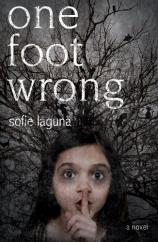Reading Group Guide
Discussion Questions
One Foot Wrong

1. Hester makes “friends” with inanimate objects --- tree, handle, table, chair, broom, axe, and spoon. What does each of these objects represent to Hester?
2. The only two books Hester is permitted to look at are The Abridged Picture Bible and Illustrated Hymns. Discuss the irony of Katherine (“Sack”) and John (“Boot”)’s religious nature in light of the way they choose to raise their child.
3. When confronted by government officials, teachers, and medical professionals, Boot and Sack speak of Hester as having mental problems. Did you get the impression that Hester would have been mentally ill had she not been raised in isolation? How do you think Hester’s abuse escaped the detection of these professionals?
4. Who is crueler to Hester in your eyes, Boot or Sack? Why? Discuss whether either parent displayed any moments of kindness or remorse for his or her actions. Do you think Sack was aware of Boot’s sexual abuse of Hester? If so, why do you think she did not try to put a stop to it?
5. After keeping Hester so hidden away, why does Sack finally take her to meet her grandmother? Mog is delighted to meet Hester and tells Hester that she needs her. In what ways do you suppose this is true? Hester states that she wants to let her secrets out to Mog. Why is Hester so at ease in Mog’s presence? Why do you suppose this setting also leads Sack to ultimately open up to Hester about her own childhood abuse?
6. Boot’s hobby is building tiny ships in bottles. Discuss the symbolism of this hobby. How does his craft correlate to the way he chooses to raise his daughter?
7. “God the Bird” initially comes to Hester on her first trip to the hanging room and continues to appear to her throughout the book. What is the significance of this imagery?
8. Blackbirds and colored birds appear to Hester at various points throughout the book. What do they represent?
9. When Hester is sent to school, she makes her first real friend Mary. Why were the two girls so drawn to each other? What turns Hester against Mary? How do you presume Mary fares at school after Hester stops attending?
10. When Hester asks, “What is a friend?” God the Bird explains that “a friend gives you pictures.” Who gives Hester pictures? What significance do painting and drawing hold for Hester?
11. At Renton Hester meets Norma. Why do you think Hester insists on calling Norma “Mary” at first? How do you explain the deep connection between Norma and Hester?
12. Hester describes the exchange of thoughts she has with Mary and Norma as “traveling down a rope.” Why do you suppose human connection manifests itself in such a physical way for Hester?
13. How did Hester’s sexual experience with the guard at Renton (“blue shoes”) differ from the times she was raped by Boot? What feelings came over Hester during intercourse with blue shoes?
14. Hester begs Norma to take her home. What is Hester’s perception of “home” at this point? How does it change once they arrive at One Cott Road? How does it change again at the end of the book when they arrive at Harrison’s house?
15. The “Lord of the Dance” hymn comes up several times throughout the book:
Dance, then, wherever you may be;
I am the Lord of the Dance, said he.
And I’ll lead you all wherever you may be,
And I’ll lead you all in the dance, said he.
Hester sings it in school with Mary and then again with Norma in the car. What is the significance of this song to Hester, Mary, and Norma?
16. What is the significance of the swim that Norma and Hester take at the end of the book?
One Foot Wrong
- Publication Date: August 18, 2009
- Paperback: 194 pages
- Publisher: Other Press
- ISBN-10: 1590513169
- ISBN-13: 9781590513163







